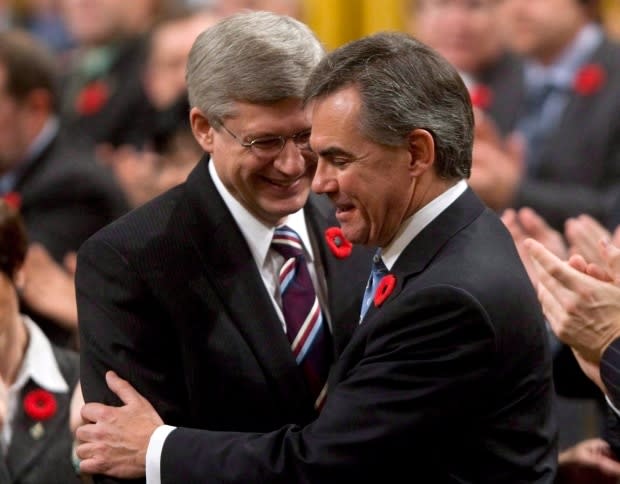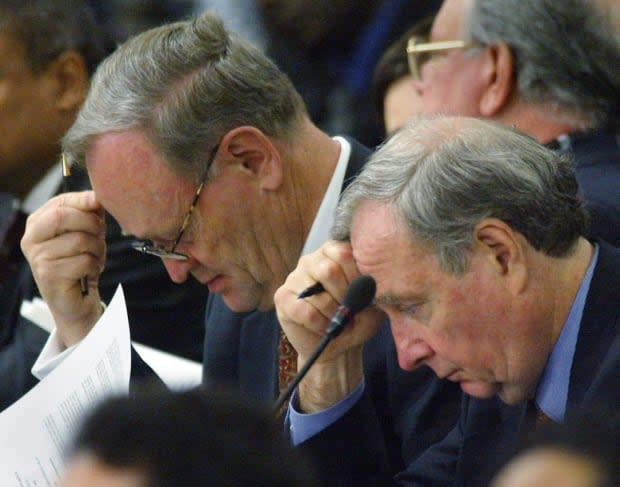Room at the top: Is Harper's legacy a Conservative leadership vacuum?
Stephen Harper left behind a relatively sturdy foundation for his successor to build on. Even in defeat, Harper's Conservative party won 99 seats and 32 per cent of the popular vote in 2015. The Conservatives raised $29 million that year, $7 million more than the Liberals.
What he didn't leave behind was an heir (or heirs) apparent. To the degree that it's still possible for a leader to plan for these things, the Conservative Party might be better off now had it put more thought into a line of succession.
The most successful run in the history of Canadian federal politics is the Liberal Party dynasty that ran from Mackenzie King's first victory in 1921 to John Turner's defeat in 1984 — an era that was held together by successful successions. Liberal prime ministers were in power for nearly 51 of those 63 years.
King himself was in power for 21 years — a feat that probably will never be matched. But while King was still in office he decided to hand power to his preferred successor, Louis St. Laurent. King had made St. Laurent his foreign minister — a role that, until then, generally had been held by the prime minister of the day — and with King's backing, St. Laurent easily won the Liberal leadership in 1948.
From St. Laurent to Pearson to Trudeau
St. Laurent held office for nearly nine years, until the Liberals were defeated by John Diefenbaker's Progressive Conservatives in 1957. St. Laurent initially was reluctant to resign as the party's leader but, according to one account, agreed to do so when he was assured that Lester B. Pearson — recruited by King and promoted by St. Laurent — would pursue the leadership.
Despite a crushing election defeat in 1958, Pearson held on to the Liberal leadership and then became prime minister in 1963. Five years later, while still in office, he decided to step aside for a new leader. Pierre Trudeau, recruited and appointed justice minister by Pearson, emerged as the frontrunner. Except for the brief interregnum of Joe Clark's government, Trudeau governed for the next 16 years.
John Turner — who entered federal politics under Pearson but split with Trudeau — was unlucky enough to go next. The Liberals' run of successful successions effectively ended with his 79 days as prime minister in 1984 and the landslide victory of Brian Mulroney's Progressive Conservatives.

Jean Chrétien, who had come into Parliament under Pearson and served in cabinet under Trudeau, returned the Liberals to power in 1993.
The long and destructive intra-party war between Chrétien and Paul Martin that followed offered a lesson in the unintended consequences of a party succession that isn't handled well — consequences that included the ill-fated turns of Stéphane Dion and Michael Ignatieff, two people who were ill-suited to the tasks they were given.
It's possible that politics has changed too much to allow for the kind of transfers of power that sustained the Liberals for half a century. Open leadership votes have put such contests beyond the easy control of party power brokers. And there's less tolerance within parties now for leaders who lose elections, as Pearson did in 1958 and 1962.
For that matter, simple hand-offs of power might deprive both parties and the country of important debates about policies and values.
But the post-Harper era also doesn't seem to offer a new model for political succession.
A missed opportunity in 2017
The first Conservative leadership race after Harper was noteworthy for all the candidates who didn't run. The top two contenders in 2017 ended up being someone who had never served in Harper's cabinet (Andrew Scheer) and someone who was most famous for being fired from Harper's cabinet (Maxime Bernier).
The second post-Harper race will feature at least one prominent name: Peter MacKay. But MacKay may end up spending more time answering for the trouble he found as a Harper minister (the F-35 procurement, the failed attempt to put Marc Nadon on the Supreme Court, his public suggestion that the chief justice had inappropriately raised concerns about that appointment, that helicopter ride) than he does boasting of any accomplishments.
With a few notable exceptions, Harper did not surround himself with a team of strong ministers known for advancing policy or handling difficult situations. (For all the attention and praise that was directed at Rona Ambrose before she ruled herself out of the race, most of her aura of credibility was due to what she did as interim party leader after 2015.) And none of those notable exceptions were able or willing to run for the leadership when Harper finally departed.
Jim Prentice — the closest Harper ever had to a deputy prime minister — left federal politics in 2010 to embark on an ill-fated run at provincial politics in Alberta; he died in a plane crash in 2016. Jim Flaherty, the veteran finance minister, resigned in March 2014 and passed away months later. James Moore, a former industry and heritage minister, resigned for family reasons in 2015. Jason Kenney, perhaps the most highly praised member of Harper's cabinet, chose to pursue power in Alberta.

Much has been made about the decline of "cabinet government" in Canada in favour of a system where only the prime minister and his office really matter. While that decline can be seen as bad for democracy, it also might make it harder to establish a healthy line of succession. At the moment, it doesn't appear that Harper will be able to take much credit for setting up any of his potential successors.
In an alternate universe, Harper might have found a way to hand the party off to someone like Prentice in 2013. And even if the Liberals still won the 2015 election in that alternate universe, the party might have been willing to let Prentice stay on for at least one more election.
It's too early to plan Justin Trudeau's retirement party, but he might start thinking about giving his party some options to choose from when it's time to find a new leader.
When Trudeau came to office in 2015, he proclaimed the return of cabinet government. His success in that regard is debatable — particularly since Jane Philpott, one of the most competent ministers of the first four years of Trudeau's government, is out of politics and no longer a Liberal.
The elevation of Chrystia Freeland to deputy prime minister might present one possible option for succession. But she needn't be the only possible heir. In 1968, when Pearson decided to step aside, Pierre Trudeau was one of eight cabinet ministers to enter the leadership race.
When Harper left, the party he led was still standing — something that makes his record look better than that of, say, Brian Mulroney.
But the party might be better off now if he'd left it with more potential successors.


